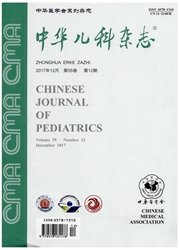

 中文摘要:
中文摘要:
目的探讨常染色体隐性遗传Shwachman—Diamond综合征(SDS)患儿的临床特点、基因特征。方法对2例经临床和基因突变分析明确诊断的SDS患儿,回顾性分析临床特点、实验室及影像学表现、基因测序结果,并对2004年以来国外报道的311例中临床与基因突变资料完整的病例进行了文献复习。结果(1)2例患儿均表现为体重、身高明显落后,低于正常同龄男童相应参考值的第3百分位点,外周血象中性粒细胞绝对计数〈1500×106/L,四肢长骨x线片表现有骨质密度异常,腹部cT显示胰腺脂肪化;SBDS基因突变检测明确2例患儿均存在基因复合杂合突变,确诊为SDS。(2)回顾国外报道的311例患儿资料,临床资料完整的共75例,其中胰腺外分泌不足或胰腺影像学异常表现、中性粒细胞减少和骨骼异常分别为61例(81.3%)、64例(85.3%)和47例(62.7%)。基因突变资料完整共138例,其中。183—184TA〉CT,C.258+2T〉C以及c.f183184TA〉CT;258+2T〉C]占基因突变的61.6%(85/138)。结论SDS患儿常见临床三大表现为:胰腺脂肪化和外分泌不足、外周血象中至少一系下降,尤其中性粒细胞减少和骨骼异常。SBDS基因检测能够发现致病突变。
 英文摘要:
英文摘要:
Objective To study clinical features and gene mutations in Shwachman-Diamond syndrome (SDS) , a rare autosomal recessive disease,in children. Method Clinical manifestations ,laboratory examinations, image studies, and genetic testing of two cases with SDS were presented, analyzed, and discussed ; 311 SDS cases from the related literature since 2004 were reviewed. Result ( 1 ) The two cases both presented with characteristic exocrine pancreatic insufficiency evidenced by abnormal pancreas on imaging and growth retardation, persistent or intermittent neutropenia ( 〈 1500 x 106/L ) and/or anemia, and skeletal abnormalities. Analysis of the SBDS gene revealed the same compound heterozygous genotype (c. 183_184TA 〉 CT,c. 258 + 2T 〉 C) for both subjects. This genotype is the result of the inheritance of abnormal alleles from both healthy parents. (2) Among 311 cases, 75 cases having complete clinical data were characterized by exocrine pancreatic dysfunction (61/75; 81.3% ), hematologic abnormalities with single- or multi-lineage cytopenia (64/75; 85.3% ) ,and bone abnormalities (47/75; 62. 7% ). c. 183_184TA 〉 CT,c. 258 + 2T 〉 C,and c. [ 183_184TA 〉 CT; 258 + 2T 〉 C~ are the major types of SBDS gene mutation(85/138 ;61.6% ). Conclusion SDS is characterized by exocrine pancreatic dysfunction with malabsorption, malnutrition, and growth failure; hematologic abnormalities with single- or multi-lineage cytopenia, and bone abnormalities. The diagnosis of SDS relies on a combination of clinical features and gene-based tests. The SDS patients need long term follow-up and management.
 同期刊论文项目
同期刊论文项目
 同项目期刊论文
同项目期刊论文
 期刊信息
期刊信息
